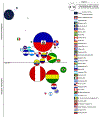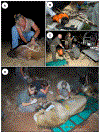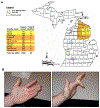The Many Hosts of Mycobacteria 9 (MHM9): A conference report
- PMID: 37531864
- PMCID: PMC10529179
- DOI: 10.1016/j.tube.2023.102377
The Many Hosts of Mycobacteria 9 (MHM9): A conference report
Abstract
The Many Hosts of Mycobacteria (MHM) meeting series brings together basic scientists, clinicians and veterinarians to promote robust discussion and dissemination of recent advances in our knowledge of numerous mycobacterial diseases, including human and bovine tuberculosis (TB), nontuberculous mycobacteria (NTM) infection, Hansen's disease (leprosy), Buruli ulcer and Johne's disease. The 9th MHM conference (MHM9) was held in July 2022 at The Ohio State University (OSU) and centered around the theme of "Confounders of Mycobacterial Disease." Confounders can and often do drive the transmission of mycobacterial diseases, as well as impact surveillance and treatment outcomes. Various confounders were presented and discussed at MHM9 including those that originate from the host (comorbidities and coinfections) as well as those arising from the environment (e.g., zoonotic exposures), economic inequality (e.g. healthcare disparities), stigma (a confounder of leprosy and TB for millennia), and historical neglect (a confounder in Native American Nations). This conference report summarizes select talks given at MHM9 highlighting recent research advances, as well as talks regarding the historic and ongoing impact of TB and other infectious diseases on Native American Nations, including those in Southwestern Alaska where the regional TB incidence rate is among the highest in the Western hemisphere.
Copyright © 2023 Elsevier Ltd. All rights reserved.
Figures










References
Publication types
MeSH terms
Grants and funding
LinkOut - more resources
Full Text Sources
Medical
Molecular Biology Databases

